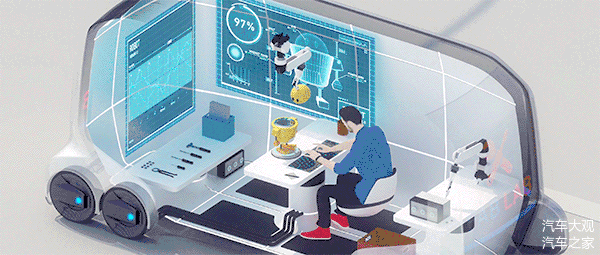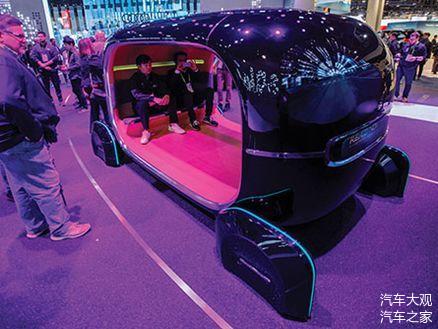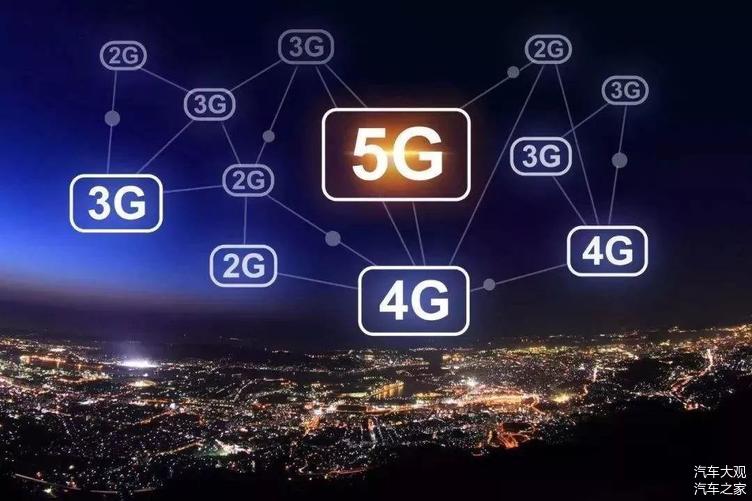When sitting in the car, you don’t need to control the steering wheel or touch the dashboard. Through gesture recognition, heart rate recognition, face recognition and other technologies, a word, a look or even a thought can allow you to control the car in the blink of an eye.
This scene, which can only be seen in science fiction movies, may be how you drive in 10 years.
In the field of smart car industry and technology, such a collection of human-computer interaction technology systems is called "smart cockpit". At present, it has become the main object of display for car companies and is praised by many industry insiders as the core technology point of the transformation of the automobile industry.

Image source: BMW official website
The market for this technology is also full of imagination. According to Visteon's forecast, in the next 10 years, automotive electronics will focus on cockpit electronics and advanced driver assistance systems (ADAS). Although the current penetration rate is generally less than 10%, this also means that the future market space is extremely huge.
The CEO of the automotive parts company Faurecia, Carlos Correta, believes that “the market size of the intelligent future cockpit is expected to reach 81 billion euros by 2030.”
But demonstration is only the first step. Just like the beautiful vision of concept cars, in the process of landing on physical cars, the smart cockpit must go through repeated tests and market adjustments, and finally be delivered to consumers, which is the key to "driving with eyes".
Interactive entrance between people and cars
What upgrades does the smart cockpit have compared to traditional car interior space?
"The automotive electronic and electrical architecture is undergoing a deep upgrade, extending from a traditional distributed architecture to a centralized architecture. Different operating systems are connected through virtualization technology to form a centralized domain architecture diagram for automotive electronics. The smart cockpit becomes a domain controller, realizing a host that integrates related components and functions such as instruments, entertainment that supports central control, rear seat screens, and vehicle control." Meng Lingjun, vice president of Neusoft Group and general manager of Neusoft Automotive Electronics Business Unit, told a reporter from China Business Weekly.
In other words, the smart cockpit will break away from the single scene of "driving" and gradually evolve into a smart space that integrates home, entertainment, social interaction, etc.
At the hardware level, the most obvious is that seats and other interior configurations can be replaced more conveniently, improving the usability of the interior space. For example, Magna's configurable cockpit and Toyota's e-Palette concept share a replaceable space, which can provide a variety of interior settings and changes, expand the space to complete meetings or entertainment activities, and be hidden when not needed.

Source: Toyota China official Weibo
At the software level, the in-vehicle devices of the smart cockpit can achieve more interactions. The smart cockpit not only has a large screen on the center console, but also two screens in front of the rear seats. HUD (head-up display) is also a device that vehicle manufacturers are vigorously promoting. These screens can be interconnected through gestures, voice and other operations to feedback content related to human-computer interaction.

Image source: Byton Automobile official website
Biometric technologies such as fingerprint unlocking, eye tracking, and facial recognition will also interact with users in the smart cockpit. Some car companies have said they will launch an emotion recognition system that uses sensors to sense passengers' facial expressions, heart rate activities, and other parameters to adjust the vehicle.
Even more "exaggerated" is Nissan, which has also proposed brain-controlled car (B2V) technology in the smart cockpit, relying on brain wave sensors to collect the human brain's feedback on the surrounding things. To put it more exaggeratedly, it is to control the car by consciousness.
In addition to internal interconnection, interconnection with external devices is also an important path for the development of smart cockpits.
The cockpit can be remotely monitored and controlled by connecting to relevant furniture, offices and other equipment. Services such as travel insurance can also be achieved through the interconnection of smart cockpits.
Zhang Qian, product director of Neusoft Group's intelligent in-vehicle interconnection product line, gave an example, saying that, for example, by connecting driving and insurance businesses, the data collection capabilities of the smart cockpit can be used to understand the driver's driving trajectory and then combine it with the background map data to help the insurance business make assessments.
Some experts also said that in the era of autonomous driving, the attributes of cars as a means of transportation will gradually be replaced by mobile smart terminals, and the smart cockpit will become a phenomenal entrance. The level of interaction between people in the car space will be deeper and more frequent.
Still a long way from being “smart”
The vision is beautiful, but can today’s smart cockpit concept really be described as “smart”?
The first thing that comes to mind is the industry's doubts about the intelligence of large and multiple screens in cars. Sun Xudong, co-founder of NE Times, said that traditional interiors can also be optimized in terms of human-computer interaction, and focusing only on three screens is a bit limited. HMI (human-machine interface) products must consider scenarios, but many scenarios are not as frequently used as everyone imagines.
In addition to the large screen, the current smart cockpit can only achieve basic facial recognition and scene interconnection. Most of the operations with external home devices are also based on third-party applications, which is far from the travel scenarios displayed.
The report "Analysis of the Development and Application Cases of Intelligent Cockpit Technology" released by the China Automotive Technology Research Center shows that the evolution of automobile intelligent cockpits is actually divided into three stages, and the current stage is the second stage - the popularization period of infotainment system integration. An industry insider told reporters that the "intelligent cockpit" promoted by major vehicle and parts suppliers at this stage is just a temporary transitional product with a partial electronicization.

Image source: CES official website
Why is a truly smart cockpit so difficult to achieve?
In addition to the limitations of high technical barriers, from the current industry development model, the integration and mass production difficulties between automobile companies and Internet companies are also important factors.
Some Internet companies have stated that the human-computer interaction function of the smart cockpit requires a large amount of data to train the algorithm to produce more intelligent feedback. However, traditional car companies are not willing to disclose data to the outside world. When cooperating with traditional car companies, it is difficult to effectively obtain vehicle and driving data, and the technology integration is not efficient.
Even if car companies have a strong desire, it does not mean that the integration will be smooth.
For example, in order to connect with external devices, car companies need to communicate data with manufacturers of home and office equipment, but each manufacturer has its own corresponding interface, and these interfaces are not unified. Faced with the game of traffic and interests behind the scenes, these interfaces also have different opening conditions. How to negotiate will become a difficult problem faced by vehicle manufacturers and suppliers.
At the same time, the quality and quantity of components such as the ECU on-board computer system in the smart cockpit have increased significantly. In the context that the technology has not yet been widely popularized, the cost of the smart cockpit is very high and mass production is difficult to achieve.
Taking the wiring harness system as an example, the wiring harness system cost of a mid-to-high-end car is around US$550-650. In the era of intelligent driving, the required wiring harness will be longer, which will increase by at least US$1,000.
The same is true for car screens. The price of a 12-inch display panel has reached US$100-120, but the current display material prices fluctuate dramatically and the OLED yield is low, which cannot yet reach automotive grade. If a curved screen is used, the cost will be several times higher than that of a flat screen.
Waiting for 5G standards to follow up
Some professionals believe that the development of smart cockpits is not isolated. In addition to internal coordination within enterprises, cooperation with external industries is the key to development.
"If we separate intelligent networking, one is intelligence and the other is networking. In fact, the cockpit just happens to undertake these two parts. This requires the gradual follow-up of external infrastructure and road standards." Meng Lingjun said.
5G technology will be an important factor in achieving technological breakthroughs and reducing mass production costs in smart cockpits.
Continuously acquiring data is the basis for the evolution of smart cockpits. This requires not only the cooperation of hardware sensors such as cameras, but also communication with perception hardware installed on the road side, which is the vehicle-to-everything (V2X) technology in the field of smart driving.

The technical advantages of 5G's high bandwidth, low latency, and high concurrency are highly integrated with V2X, which will provide more scenarios for smart cockpits: autonomous recognition of traffic signs, synchronization of basic information on urban road conditions, automatic adjustment of speed based on the speed of the object ahead, and even the development of insurance and financial services.
Previous article:Tesla announces Dojo project to achieve fully autonomous driving
Next article:Renesas' innovative automotive electronics chip is used in ProPILOT 2.0 intelligent control system
- Popular Resources
- Popular amplifiers
- Car key in the left hand, liveness detection radar in the right hand, UWB is imperative for cars!
- After a decade of rapid development, domestic CIS has entered the market
- Aegis Dagger Battery + Thor EM-i Super Hybrid, Geely New Energy has thrown out two "king bombs"
- A brief discussion on functional safety - fault, error, and failure
- In the smart car 2.0 cycle, these core industry chains are facing major opportunities!
- The United States and Japan are developing new batteries. CATL faces challenges? How should China's new energy battery industry respond?
- Murata launches high-precision 6-axis inertial sensor for automobiles
- Ford patents pre-charge alarm to help save costs and respond to emergencies
- New real-time microcontroller system from Texas Instruments enables smarter processing in automotive and industrial applications
- Innolux's intelligent steer-by-wire solution makes cars smarter and safer
- 8051 MCU - Parity Check
- How to efficiently balance the sensitivity of tactile sensing interfaces
- What should I do if the servo motor shakes? What causes the servo motor to shake quickly?
- 【Brushless Motor】Analysis of three-phase BLDC motor and sharing of two popular development boards
- Midea Industrial Technology's subsidiaries Clou Electronics and Hekang New Energy jointly appeared at the Munich Battery Energy Storage Exhibition and Solar Energy Exhibition
- Guoxin Sichen | Application of ferroelectric memory PB85RS2MC in power battery management, with a capacity of 2M
- Analysis of common faults of frequency converter
- In a head-on competition with Qualcomm, what kind of cockpit products has Intel come up with?
- Dalian Rongke's all-vanadium liquid flow battery energy storage equipment industrialization project has entered the sprint stage before production
- Allegro MicroSystems Introduces Advanced Magnetic and Inductive Position Sensing Solutions at Electronica 2024
- Car key in the left hand, liveness detection radar in the right hand, UWB is imperative for cars!
- After a decade of rapid development, domestic CIS has entered the market
- Aegis Dagger Battery + Thor EM-i Super Hybrid, Geely New Energy has thrown out two "king bombs"
- A brief discussion on functional safety - fault, error, and failure
- In the smart car 2.0 cycle, these core industry chains are facing major opportunities!
- The United States and Japan are developing new batteries. CATL faces challenges? How should China's new energy battery industry respond?
- Murata launches high-precision 6-axis inertial sensor for automobiles
- Ford patents pre-charge alarm to help save costs and respond to emergencies
- New real-time microcontroller system from Texas Instruments enables smarter processing in automotive and industrial applications
- How to ensure thermal safety of automotive infotainment and cluster systems?
- Reference circuit design of antenna chip for SE2436L
- CC1310/CC1350 with TI-RTOS operating system Sensor, Collector routine frequency hopping mode communication details
- EEWORLD University ---- NXP Tech Video
- [Repost] I realized that the application range of crystal oscillators is so wide.
- Original new Fluke 561 contact and infrared thermometer for sale
- Tutorial on using PARAM in EDMA3
- How to control the harmonics of a 25W RF power amplifier to -80dBc?
- Problems encountered after reinstalling AD14.3
- Why should we learn about transistor circuits when there are integrated circuits?



 THS4503MDGNREPR
THS4503MDGNREPR











 京公网安备 11010802033920号
京公网安备 11010802033920号